stop start TOYOTA AVALON 2016 XX40 / 4.G Quick Reference Guide
[x] Cancel search | Manufacturer: TOYOTA, Model Year: 2016, Model line: AVALON, Model: TOYOTA AVALON 2016 XX40 / 4.GPages: 52, PDF Size: 2.04 MB
Page 5 of 52
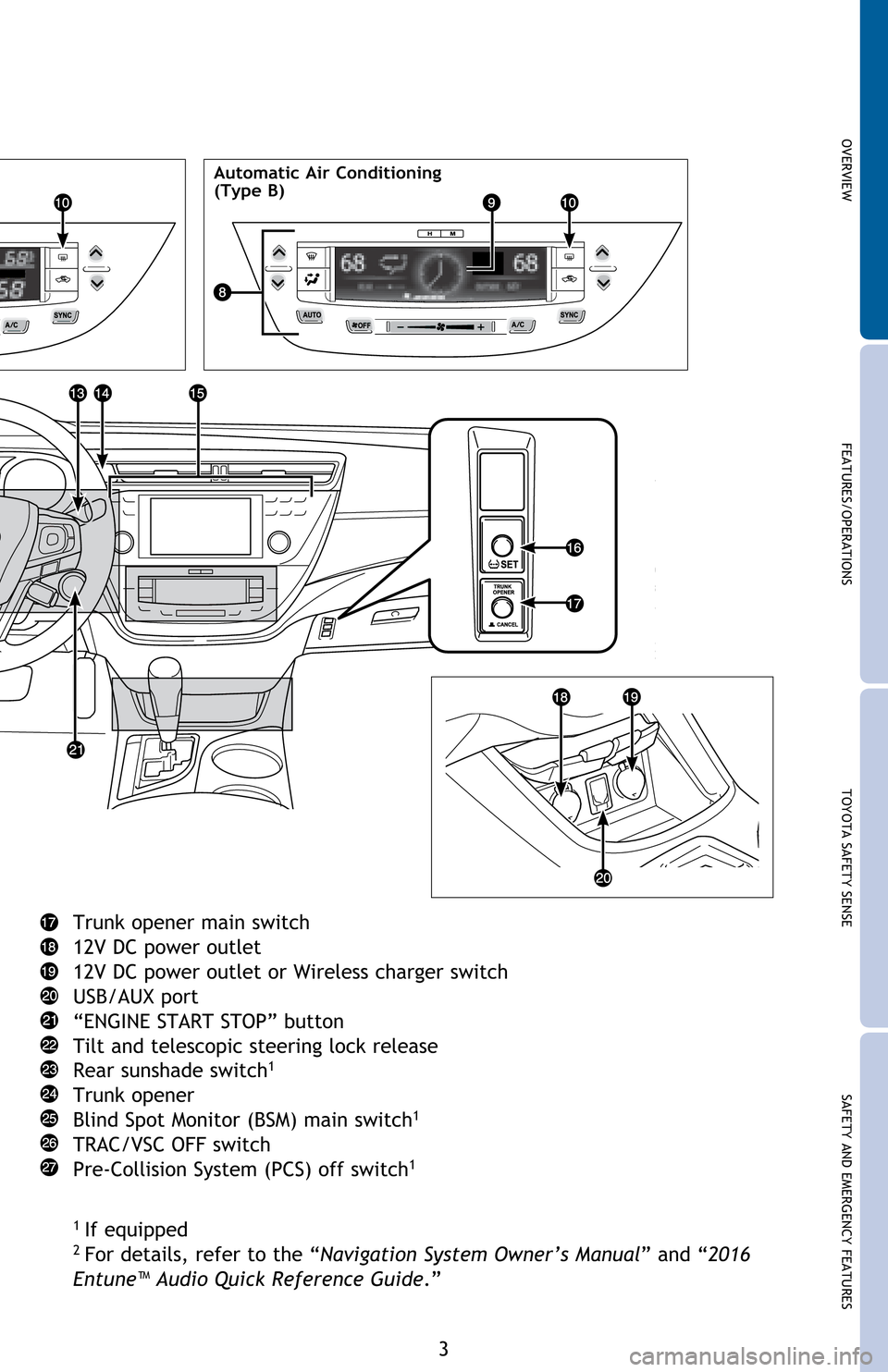
OVERVIEW FEATURES/OPERATIONS TOYOTA SAFETY SENSE SAFETY AND EMERGENCY FEATURES
3
Trunk opener main switch
12V DC power outlet
12V DC power outlet or Wireless charger switch
USB/AUX port
“ENGINE START STOP” button
Tilt and telescopic steering lock release
Rear sunshade switch
1
Trunk opener
Blind Spot Monitor (BSM) main switch1
TRAC/VSC OFF switch
Pre-Collision System (PCS) off switch1
1
If equipped2
For details, refer to the “Navigation System Owner’s Manual” and “2016
Entune™ Audio Quick Reference Guide.”
Automatic Air Conditioning
(Type B)
Page 9 of 52
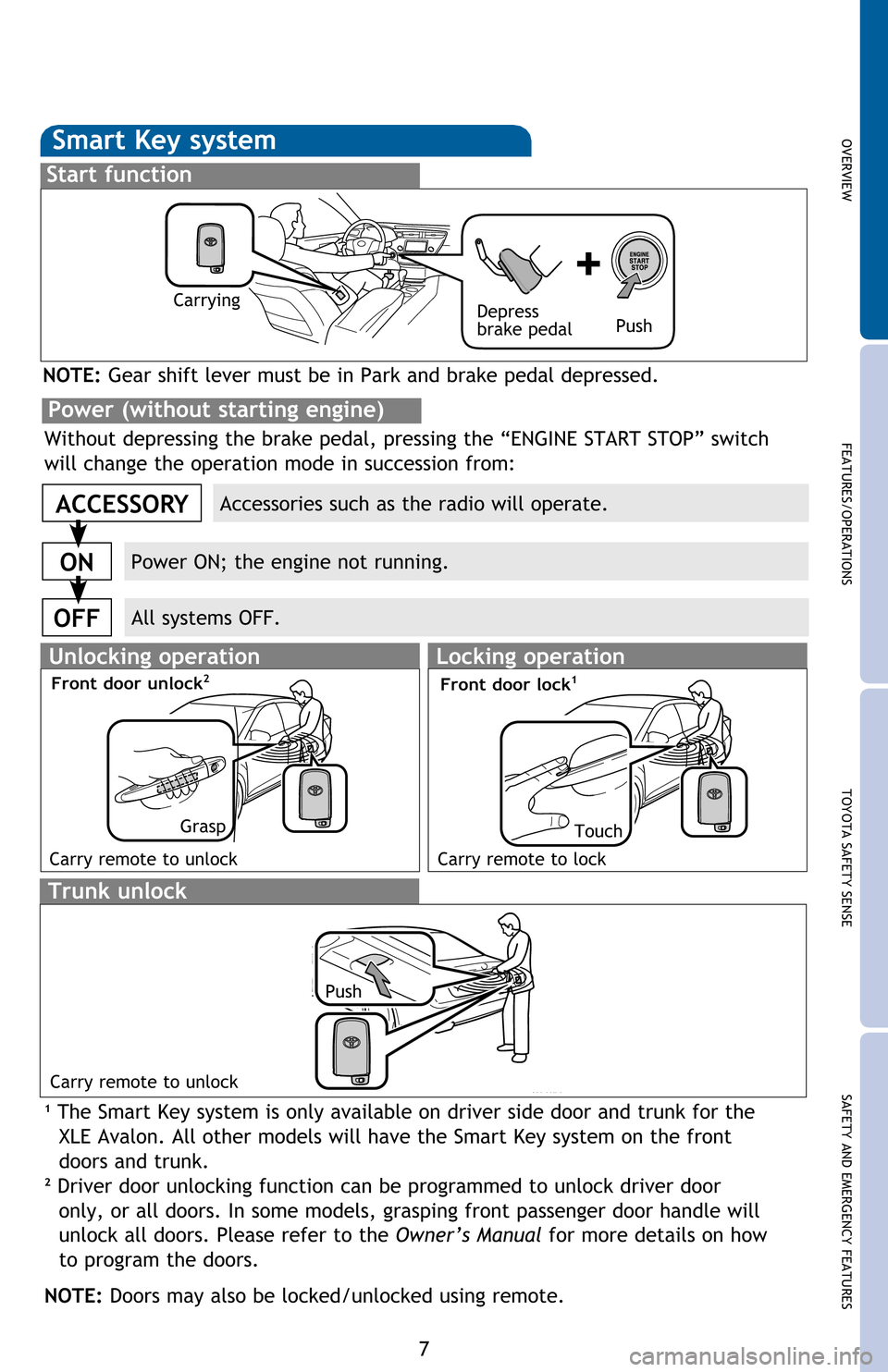
OVERVIEW FEATURES/OPERATIONS TOYOTA SAFETY SENSE SAFETY AND EMERGENCY FEATURES
7 NOTE: Gear shift lever must be in Park and brake pedal depressed.
Smart Key system
Start function
Push Depress
brake pedal
Carrying
1 The Smart Key system is only available on driver side door and trunk for the
XLE Avalon. All other models will have the Smart Key system on the front
doors and trunk.
2 Driver door unlocking function can be programmed to unlock driver door
only, or all doors. In some models, grasping front passenger door handle will
unlock all doors. Please refer to the Owner’s Manual for more details on how
to program the doors.
NOTE: Doors may also be locked/unlocked using remote.
Accessories such as the radio will operate.
Power ON; the engine not running.
All systems OFF.
ACCESSORY
ON
OFF
Without depressing the brake pedal, pressing the “ENGINE START STOP” switch
will change the operation mode in succession from:
Power (without starting engine)
Trunk unlock
Push
Carry remote to unlock
Locking operation
Carry remote to lock
Front door lock1
Touch
Unlocking operation
Carry remote to unlock
Front door unlock2
Grasp
Page 12 of 52
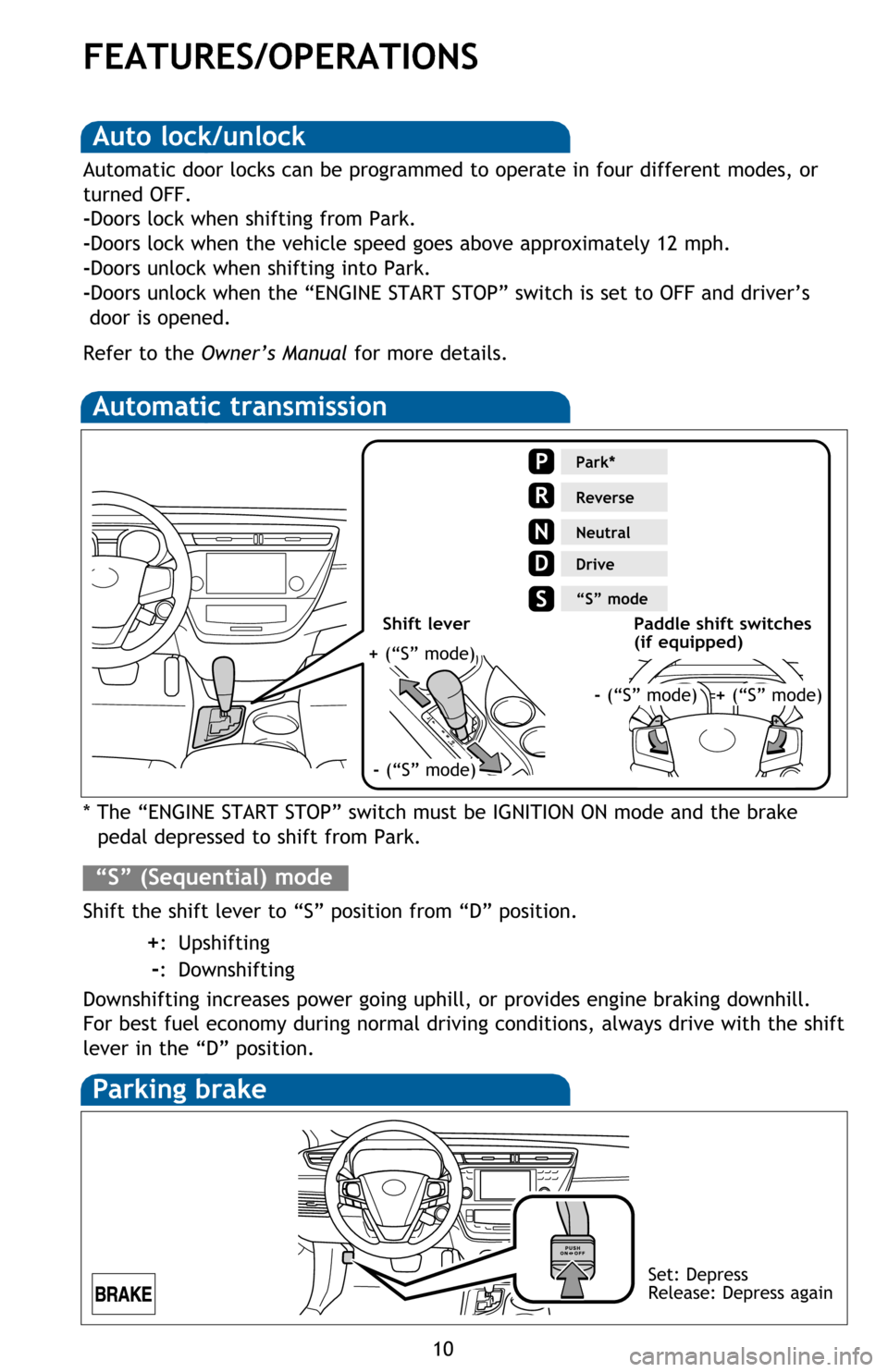
10
FEATURES/OPERATIONS
Automatic transmission
* The “ENGINE START STOP” switch must be IGNITION ON mode and the brake
pedal depressed to shift from Park.
Shift the shift lever to “S” position from “D” position.
+: Upshifting
-: Downshifting
Downshifting increases power going uphill, or provides engine braking downhill.
For best fuel economy during normal driving conditions, always drive with the shift
lever in the “D” position.
“S” (Sequential) mode
Auto lock/unlock
Automatic door locks can be programmed to operate in four different modes, or
turned OFF.
-Doors lock when shifting from Park.
-Doors lock when the vehicle speed goes above approximately 12 mph.
-Doors unlock when shifting into Park.
-Doors unlock when the “ENGINE START STOP” switch is set to OFF and driver’s
door is opened.
Refer to the Owner’s Manual for more details.
P
R
N
D
N
Park*
Reverse
Neutral
Drive
“S” mode
+ (“S” mode)
- (“S” mode)
+ (“S” mode)- (“S” mode)
Paddle shift switches
(if equipped) Shift lever
Parking brake
Set: Depress
Release: Depress again
Page 13 of 52
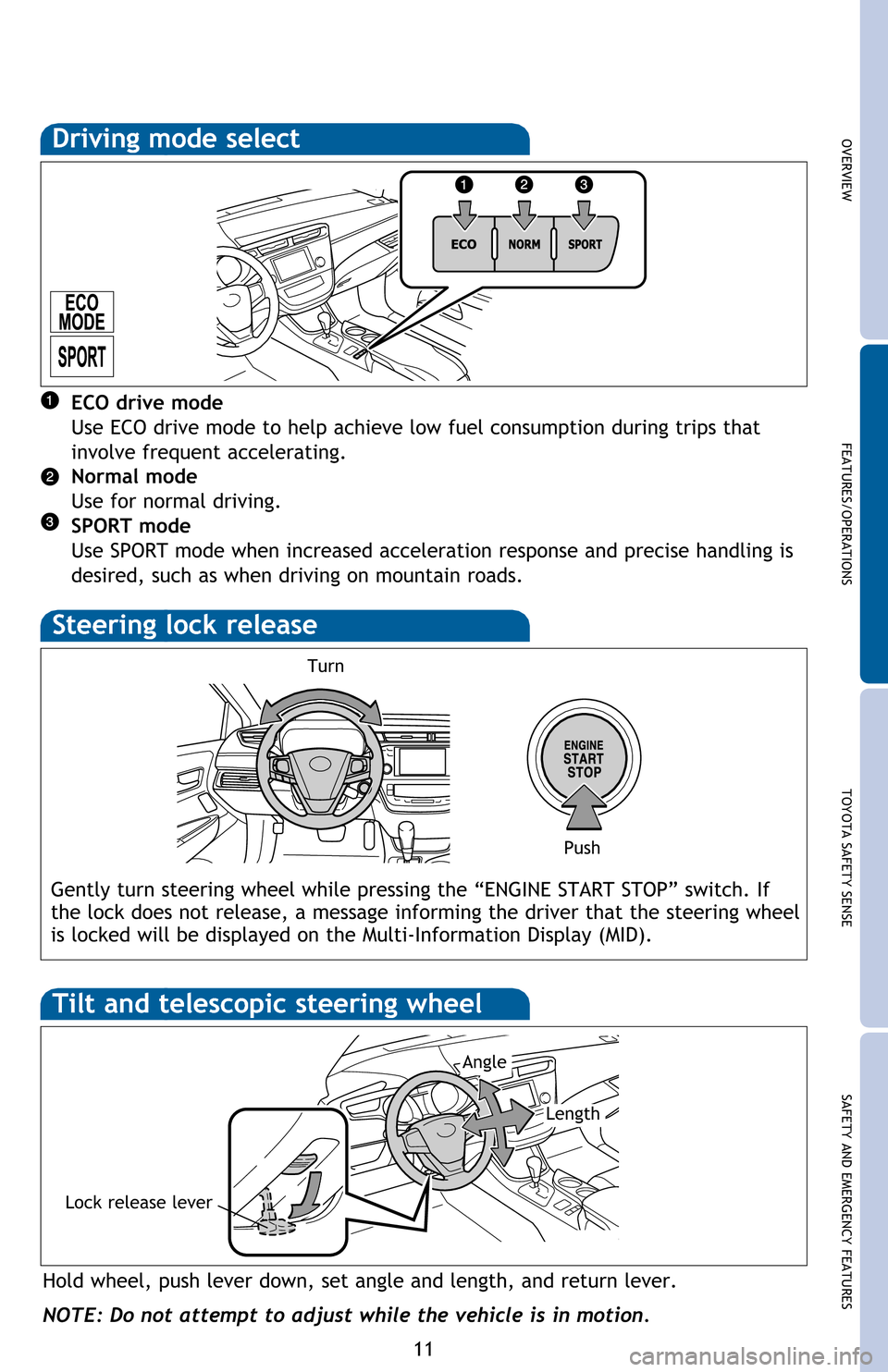
OVERVIEW FEATURES/OPERATIONS TOYOTA SAFETY SENSE SAFETY AND EMERGENCY FEATURES
11
Steering lock release
Turn
Push
Hold wheel, push lever down, set angle and length, and return lever.
Lock release lever
NOTE: Do not attempt to adjust while the vehicle is in motion.
Tilt and telescopic steering wheel
Gently turn steering wheel while pressing the “ENGINE START STOP” switch. If
the lock does not release, a message informing the driver that the steering wheel
is locked will be displayed on the Multi-Information Display (MID).
Angle
Length
Driving mode select
ECO drive mode
Use ECO drive mode to help achieve low fuel consumption during trips that
involve frequent accelerating.
Normal mode
Use for normal driving.
SPORT mode
Use SPORT mode when increased acceleration response and precise handling is
desired, such as when driving on mountain roads.
Page 19 of 52
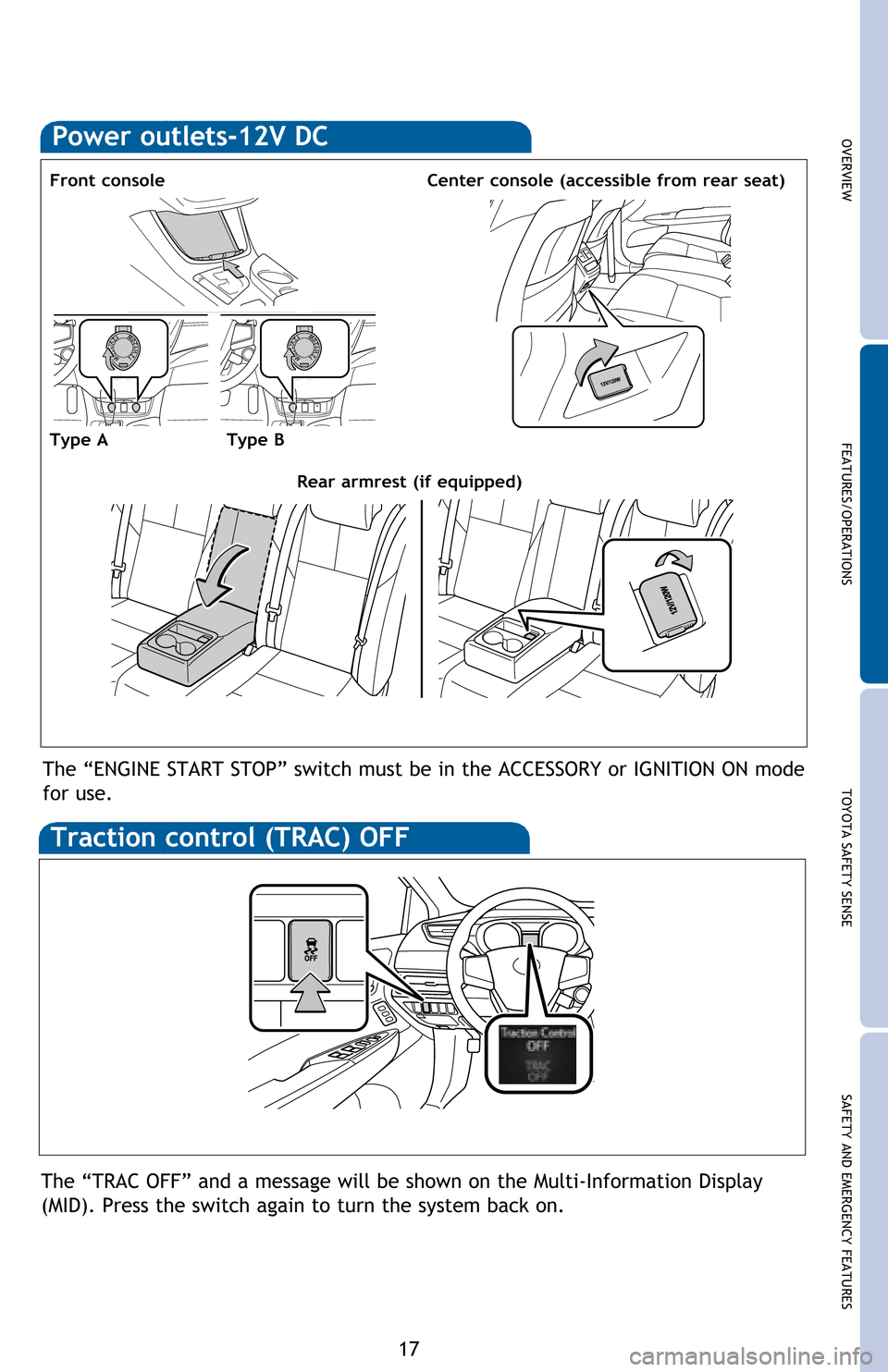
OVERVIEW FEATURES/OPERATIONS TOYOTA SAFETY SENSE SAFETY AND EMERGENCY FEATURES
17
Power outlets-12V DC
Front console
Type AType B
The “ENGINE START STOP” switch must be in the ACCESSORY or IGNITION ON mode
for use.
Center console (accessible from rear seat)
Rear armrest (if equipped)
The “TRAC OFF” and a message will be shown on the Multi-Information Display
(MID). Press the switch again to turn the system back on.
Traction control (TRAC) OFF
Page 24 of 52
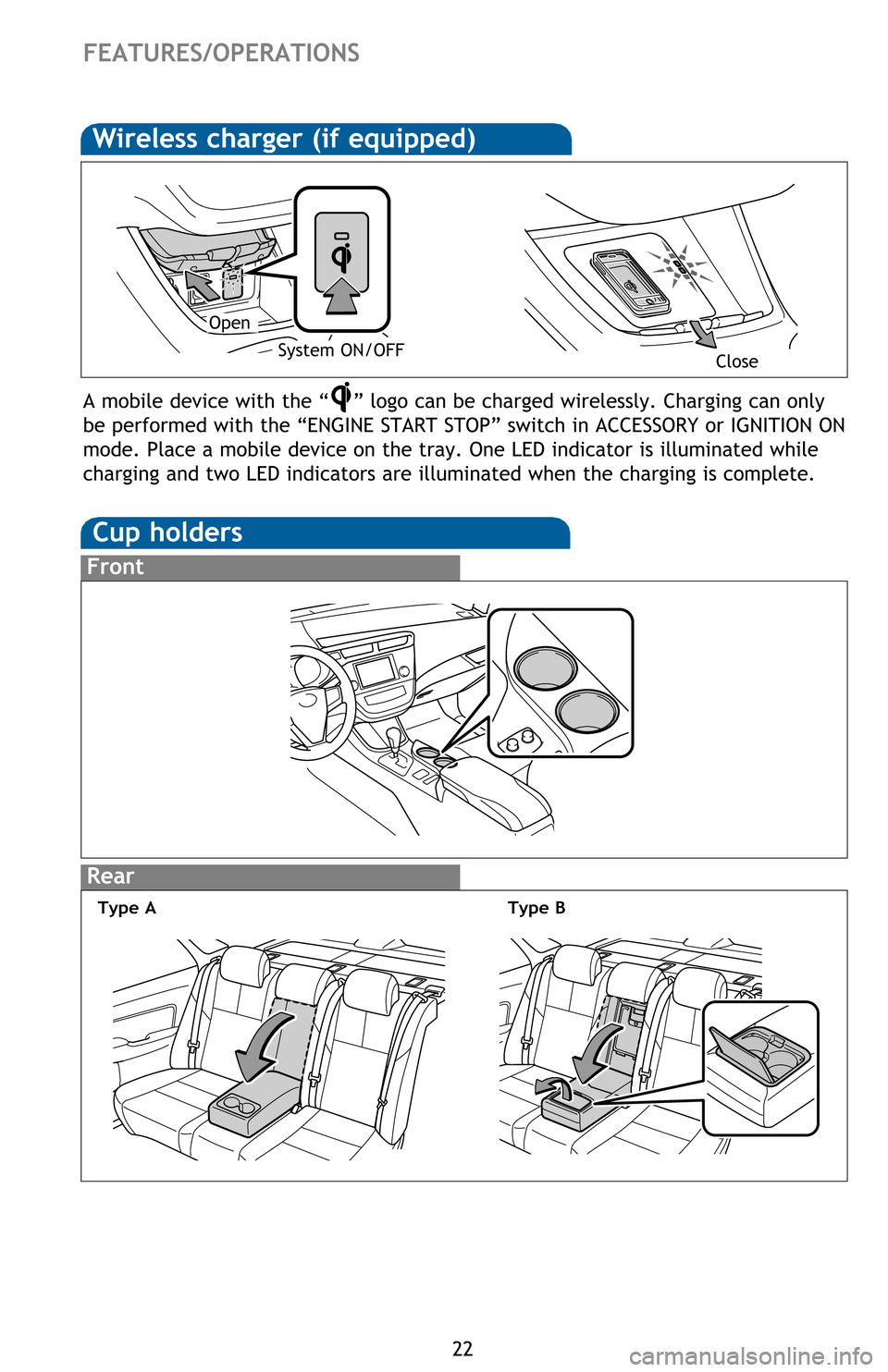
22
Rear
FEATURES/OPERATIONS
Cup holders
Front
Type AType B
Wireless charger (if equipped)
A mobile device with the “” logo can be charged wirelessly. Charging can only
be performed with the “ENGINE START STOP” switch in ACCESSORY or IGNITION ON
mode. Place a mobile device on the tray. One LED indicator is illuminated while
charging and two LED indicators are illuminated when the charging is complete.
Close
Open
System ON/OFF
Page 36 of 52
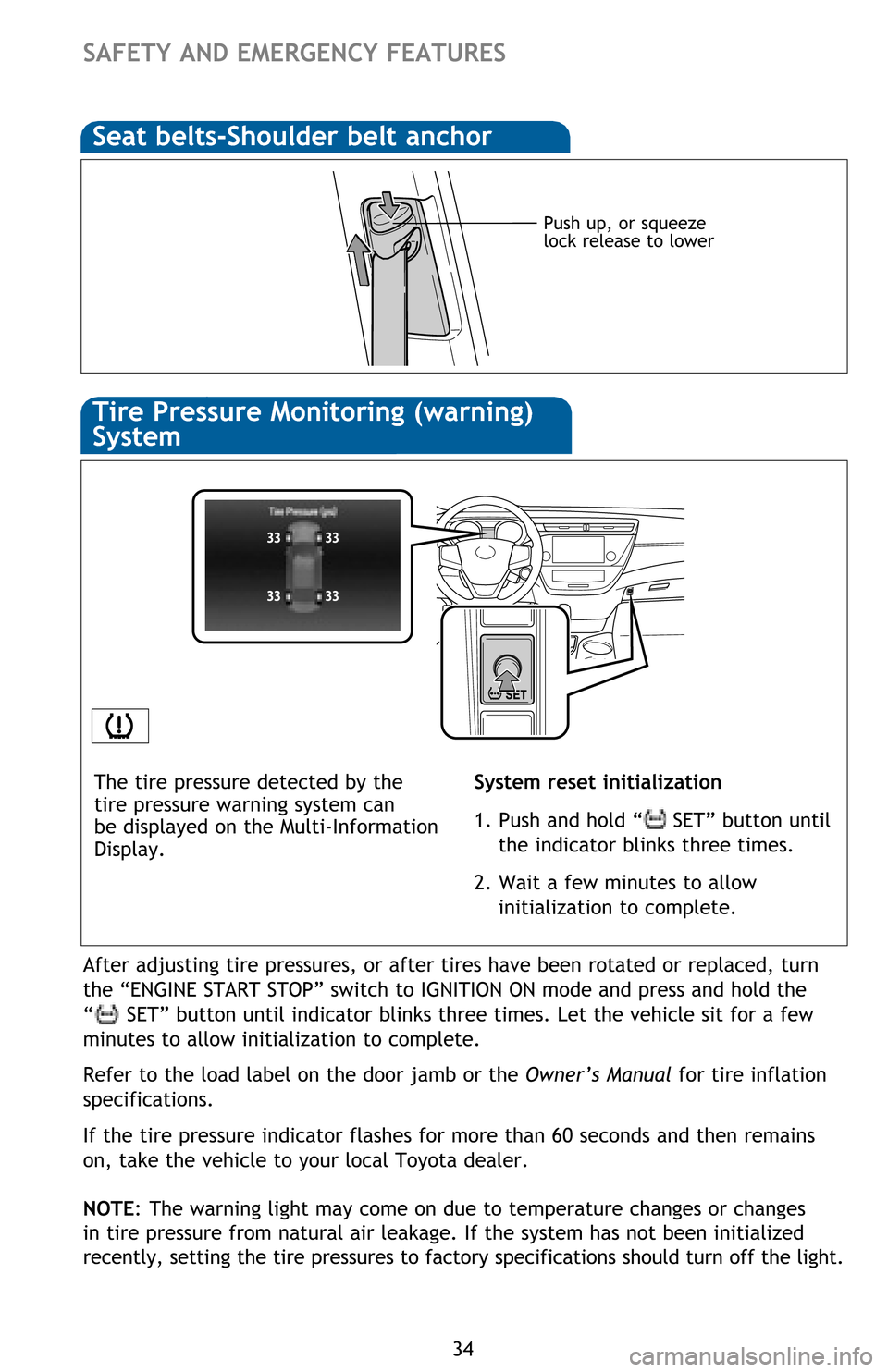
34
SAFETY AND EMERGENCY FEATURES
Push up, or squeeze
lock release to lower
System reset initialization
1. Push and hold “
SET” button until
the indicator blinks three times.
2. Wait a few minutes to allow
initialization to complete. The tire pressure detected by the
tire pressure warning system can
be displayed on the Multi-Information
Display.
Seat belts-Shoulder belt anchor
Tire Pressure Monitoring (warning)
System
After adjusting tire pressures, or after tires have been rotated or replaced, turn
the “ENGINE START STOP” switch to IGNITION ON mode and press and hold the
“
SET” button until indicator blinks three times. Let the vehicle sit for a few
minutes to allow initialization to complete.
Refer to the load label on the door jamb or the Owner’s Manual for tire inflation
specifications.
If the tire pressure indicator flashes for more than 60 seconds and then remains
on, take the vehicle to your local Toyota dealer.
NOTE: The warning light may come on due to temperature changes or changes
in tire pressure from natural air leakage. If the system has not been initialized
recently, setting the tire pressures to factory specifications should turn off the light.
Page 38 of 52
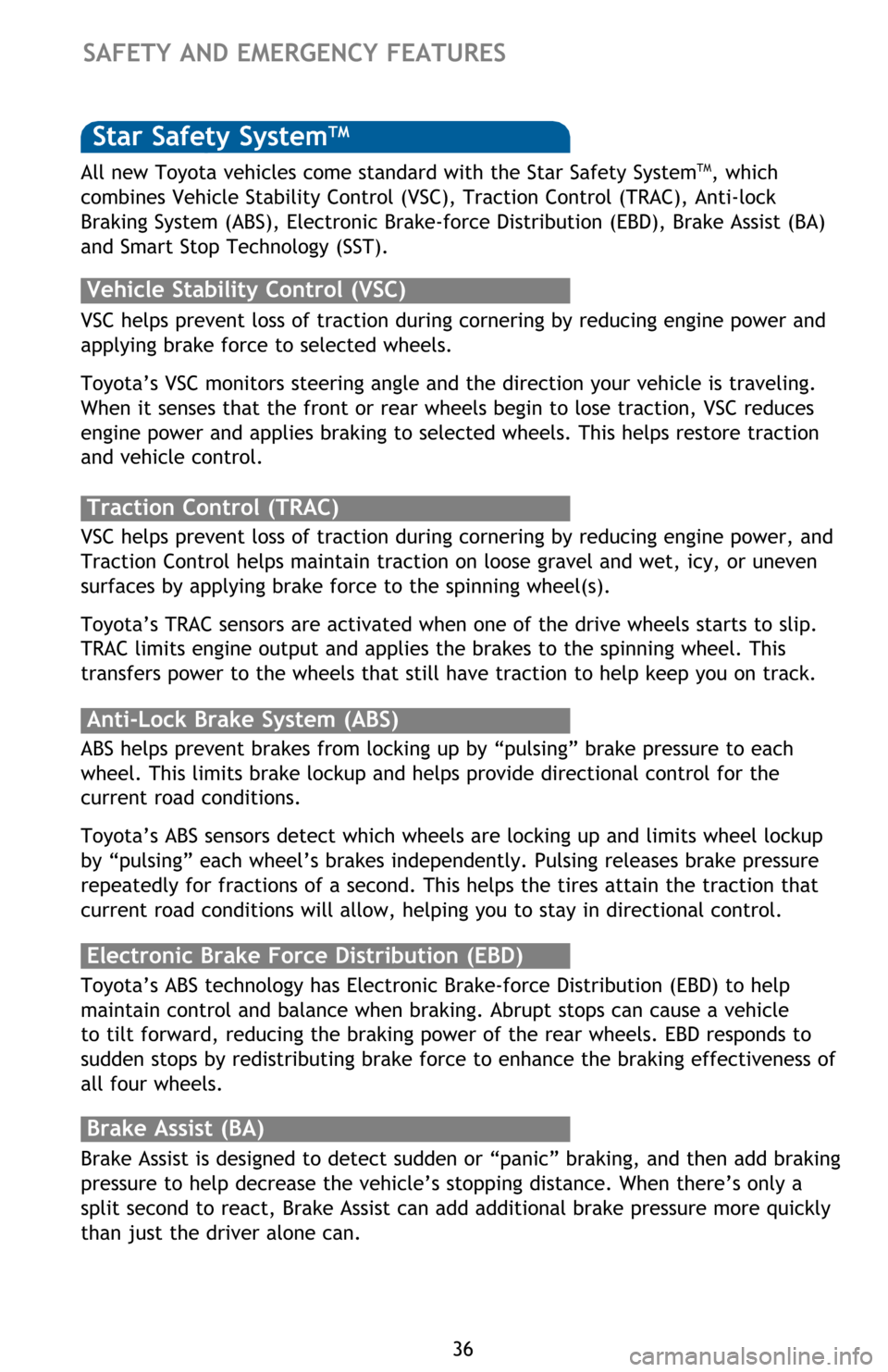
36
Star Safety SystemTM
VSC helps prevent loss of traction during cornering by reducing engine power and
applying brake force to selected wheels.
Toyota’s VSC monitors steering angle and the direction your vehicle is traveling.
When it senses that the front or rear wheels begin to lose traction, VSC reduces
engine power and applies braking to selected wheels. This helps restore traction
and vehicle control.
Vehicle Stability Control (VSC)
Anti-Lock Brake System (ABS)
ABS helps prevent brakes from locking up by “pulsing” brake pressure to each
wheel. This limits brake lockup and helps provide directional control for the
current road conditions.
Toyota’s ABS sensors detect which wheels are locking up and limits wheel lockup
by “pulsing” each wheel’s brakes independently. Pulsing releases brake pressure
repeatedly for fractions of a second. This helps the tires attain the traction that
current road conditions will allow, helping you to stay in directional control.
Brake Assist (BA)
Brake Assist is designed to detect sudden or “panic” braking, and then add braking
pressure to help decrease the vehicle’s stopping distance. When there’s only a
split second to react, Brake Assist can add additional brake pressure more quickly
than just the driver alone can. VSC helps prevent loss of traction during cornering by reducing engine power, and
Traction Control helps maintain traction on loose gravel and wet, icy, or uneven
surfaces by applying brake force to the spinning wheel(s).
Toyota’s TRAC sensors are activated when one of the drive wheels starts to slip.
TRAC limits engine output and applies the brakes to the spinning wheel. This
transfers power to the wheels that still have traction to help keep you on track.
Traction Control (TRAC)
Electronic Brake Force Distribution (EBD)
Toyota’s ABS technology has Electronic Brake-force Distribution (EBD) to help
maintain control and balance when braking. Abrupt stops can cause a vehicle
to tilt forward, reducing the braking power of the rear wheels. EBD responds to
sudden stops by redistributing brake force to enhance the braking effectiveness of
all four wheels.
SAFETY AND EMERGENCY FEATURES
All new Toyota vehicles come standard with the Star Safety SystemTM, which
combines Vehicle Stability Control (VSC), Traction Control (TRAC), Anti-lock
Braking System (ABS), Electronic Brake-force Distribution (EBD), Brake Assist (BA)
and Smart Stop Technology (SST).
Page 39 of 52
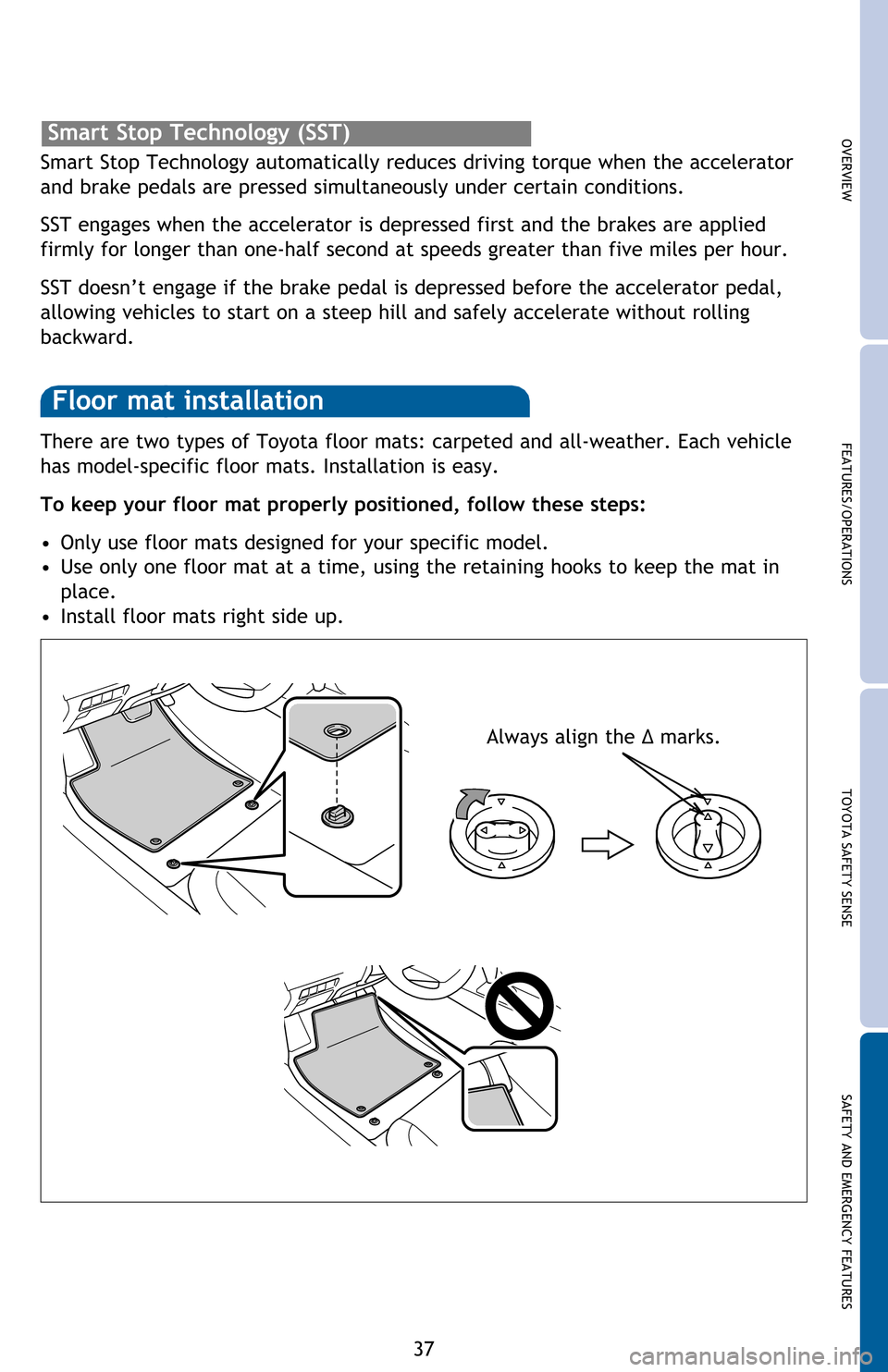
OVERVIEW FEATURES/OPERATIONS TOYOTA SAFETY SENSE SAFETY AND EMERGENCY FEATURES
37 There are two types of Toyota floor mats: carpeted and all-weather. Each vehicle
has model-specific floor mats. Installation is easy.
To keep your floor mat properly positioned, follow these steps:
• Only use floor mats designed for your specific model.
• Use only one floor mat at a time, using the retaining hooks to keep the mat in
place.
• Install floor mats right side up.
Floor mat installation
Smart Stop Technology automatically reduces driving torque when the accelerator
and brake pedals are pressed simultaneously under certain conditions.
SST engages when the accelerator is depressed first and the brakes are applied
firmly for longer than one-half second at speeds greater than five miles per hour.
SST doesn’t engage if the brake pedal is depressed before the accelerator pedal,
allowing vehicles to start on a steep hill and safely accelerate without rolling
backward.
Smart Stop Technology (SST)
Always align the �¨ marks.